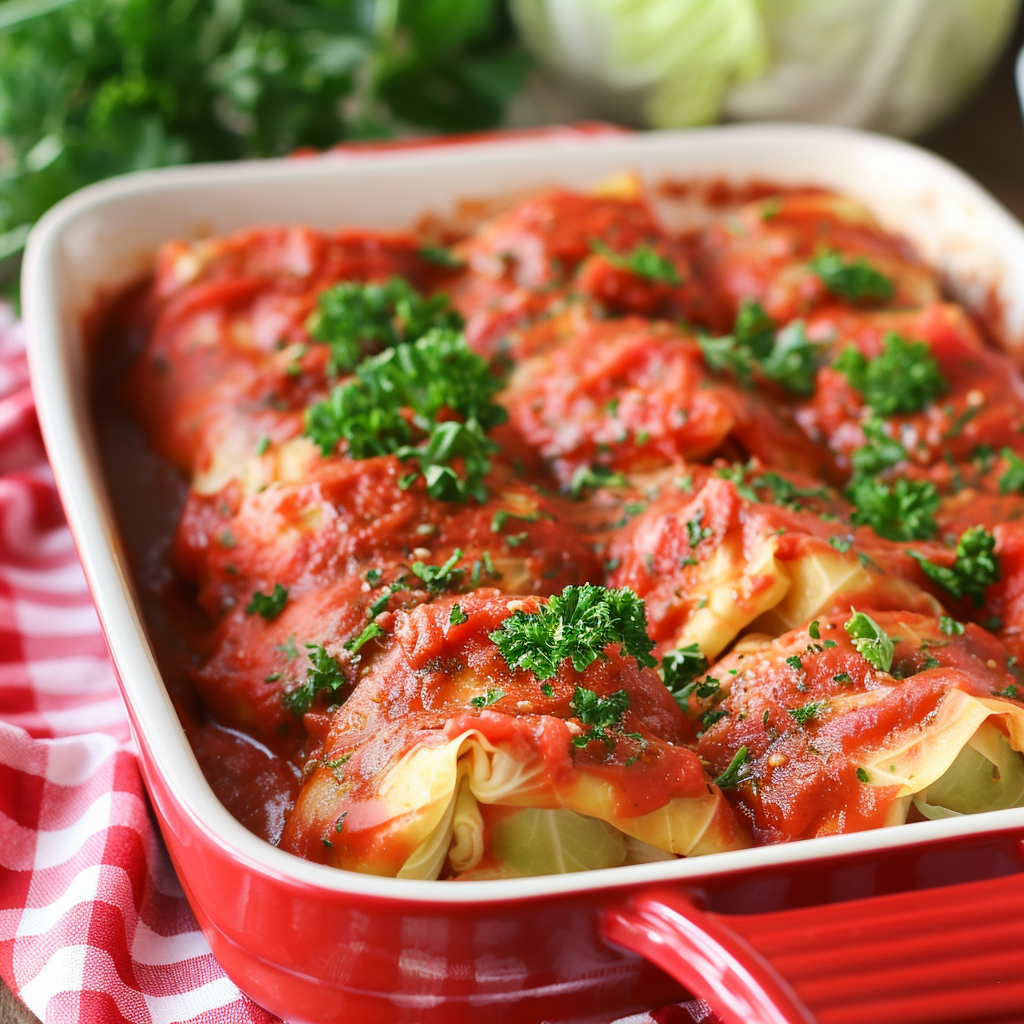Traditional Ground Beef and Rice Cabbage Rolls in a Rich Tomato Sauce

Share
Ground Beef and Rice Cabbage Rolls
Growing up in a Ukrainian household, cabbage rolls were a staple dish, but we mostly made them without meat. It wasn’t just a dietary choice but also a way to stretch ingredients for large families. The filling was typically made with rice and onions. Meatless cabbage rolls are delicious and hearty on their own, but for those that like some meat, adding ground beef brings another element to this traditional meal. Today, cabbage rolls remain a comfort food, offering a delicious blend of savory flavors wrapped in tender cabbage leaves, perfect for family gatherings or casual dinners.
Did You Know?
Cabbage rolls have been embraced by various cultures, from Eastern Europe to the Middle East, with each region adding its own twist. The dish typically includes a flavorful mix of grains and proteins wrapped in tender cabbage leaves, but the fillings can range from beef and pork to lentils and rice, depending on the culture and available ingredients. Rich in fiber and nutrients, cabbage is an ideal choice for wrapping fillings and adds a subtle flavor that complements the savory stuffing.
Yield: 6 servings
Ingredients:
1 large head of cabbage
1 pound ground beef
1 cup cooked rice
1 onion, finely chopped
2 cloves garlic, minced
1 can (10.75 oz) tomato soup
1 can (15 oz) tomato sauce (choose a brand you like the flavor of)
2 tablespoons olive oil
1 teaspoon salt
1/2 teaspoon black pepper
1 teaspoon paprika
Fresh parsley for garnish
Instructions:
Prepare the Cabbage:
Freezing Method:
Freeze the cabbage overnight. The next day, place the frozen cabbage in boiling water for a few minutes, allowing the leaves to soften and become pliable. Peel the leaves carefully as they soften.
Boiling Method:
Core the cabbage and place it in boiling water. As the outer leaves become tender, use tongs to remove them one by one.
Personal Tip: Freezing the cabbage can be more convenient if you're prepping in advance, and it helps retain more nutrients compared to boiling.
Prepare the Filling:
Heat olive oil in a skillet over medium heat.
Add onion and sauté until translucent. Add garlic and cook until fragrant.
Stir in ground beef and cook until browned.
Add cooked rice, salt, pepper, and paprika. Stir and cook for a few more minutes.
Personal Tip: Adding a dash of Worcestershire sauce to the filling gives it a deeper, richer flavor.
Assemble the Cabbage Rolls:
Preheat the oven to 350°F.
Place a spoonful of the beef and rice mixture onto each cabbage leaf, fold the sides over, and roll tightly.
Arrange rolls seam-side down in a baking dish.
Personal Tip: For a vegetarian option, you can substitute the beef with a mix of mushrooms and lentils.
Prepare the Sauce:
In a bowl, mix the tomato soup and tomato sauce. Pour a thin layer of sauce into the baking dish and place the rolls on top.
Pour the remaining sauce over the rolls, cover with foil, and bake for 1.5 to 2 hours.
Personal Tip: If you want extra texture, uncover the rolls during the last 20 minutes to allow the tops to crisp up.
Nutritional Information (Per Serving): Calories: 350, Fat: 18g, Saturated Fat: 5g, Carbohydrates: 30g, Fiber: 5g, Sugars: 8g, Protein: 18g
Kitchen Tips, Great Ideas, How to Save Money
-
Bulk Buying: Buy ground beef, rice, and tomato sauce in bulk to save money. These versatile ingredients are used in many other dishes, making them cost-effective.
-
Freezing Cabbage for Convenience: Freezing cabbage is a time-saving method that softens the leaves without losing nutrients. Plus, you can freeze leftovers for later use.
-
Eco-Friendly Bakeware: Use reusable baking dishes and silicone mats instead of disposable foil pans. They last longer and are better for the environment.
-
Smart Ingredient Substitutions: Skip artificial additives by choosing healthier alternatives for canned goods or sauces.
-
Homemade Sauce Alternative: Instead of using canned soup, make a quick tomato sauce by simmering fresh tomatoes, onions, and herbs. It’s healthier, tastes fresher, and is often more affordable.
-
Prepping in Advance: Prepare the rice and ground beef filling the night before to save time on cooking day. Store the filling in an airtight container in the fridge.
-
Creative Presentation: Enhance the dish’s presentation by garnishing with fresh herbs like dill or parsley, or by serving the rolls with colorful roasted vegetables.
-
Freezing Leftovers: Cabbage rolls freeze well, making them a great make-ahead meal. Store in airtight containers for up to three months.
-
Flavor Boosters: Add herbs like thyme or dill to the filling for extra depth of flavor without extra cost.
-
Reusable Storage Solutions: Store leftovers in reusable silicone bags or glass containers to reduce plastic waste and keep food fresher for longer.
Let’s Learn About Cabbage: Regular and Savoy
Cabbage comes in several varieties, the most common being regular green cabbage and Savoy cabbage. Regular green cabbage is known for its firm, tightly packed leaves and is ideal for traditional cabbage rolls due to its sturdy structure. Savoy cabbage, on the other hand, has a milder flavor and softer, crinkled leaves that lend a delicate texture to dishes like cabbage rolls. Both varieties are rich in vitamins C and K and are low in calories, making them a nutritious choice for many meals. When choosing between the two, consider the texture you prefer—Savoy cabbage will offer a slightly softer bite, while regular cabbage holds up better to long cooking times.


